Each dacket wishes his household plot to be beautiful and original. However, it is quite difficult to do in the conditions of our not quite favorable climate. Fortunately, there is a group of plants that feel good in the regions with a non-jar and rainy summer. Such cultures include the adonis flower. This plant grows in Asia, Europe, Russia. The most acceptable growth conditions for this flower are considered - moderate climate, an abundance of moisture, the absence of bright direct sunlight. The fact that Adonis is, as well as how to land and care for this culture is carried out - let's tell later in the article.
Adonis: Plant Description
The flower of adonis for its beauty and brightness of flowering in the people got the name of the horizon. The plant has a plant to the family of ilok. There are more than 40 varieties of this culture, and there are both annual and perennial species of adonis. It is believed that the flower name received in honor of the beautiful Prince Adonis, who loved the goddess of Aphrodite. Since the young man died in a tragic death on the hunt in the forest, his blood was painted nearby flowers in a bright red color. And after all, it really blooms the culture of Adonis is predominantly bright red flowers, thanks to which he fell in love with many dachensons.
The main distinguishing characteristics of this culture are as follows:
- The plant, as mentioned above, prefers a moderate climate and a non-good summer, so it "feels" well in conditions of our latitudes.
- Stem in culture is thin, sometimes has a branching structure (it depends on the variety of the plant).
- The leaflets have a finish-fiber structure.
- Plant blooms with large flowers that have red or bright yellow. In the diameter, the flowers can reach 5-6 cm. On each flower there are many petals, the number of which can reach 17-20 pcs.
- Adonis refers to poisonous cultures, so it should not be planted near vegetable beds.
- Culture is multiplied mainly from seeds.
The reproduction of Adonis
Adonsis reproduction occurs in two ways:
- Dividing bush. This method is used quite rarely.
- Growing adonis from seeds.
As for the first method of reproduction (the division of the bush), only adult and healthy bushes of the plants are suitable for this, which have reached 4 years of age:
- Culture transplant quite rarely, no more than once every 5-6 years. Culture is good and smashes. So, on the same glade, the plant can "live" until 15-20 years.
- A healthy bush is distributed on delays with a sharp knife. At the same time, it should be very careful to cut the rhizome, so as not to damage its structure.
- Conduct the procedure for breeding on this method at the end of summer or at the beginning of autumn, when the flowers have already been blowing away.
- Sections of sections on decenecia are treated with disinfecting compositions. Next, the seedlings should urgently sear the new zones of the site.
- Note that the chopped decene should have large sizes, otherwise they may not take care.
- If new transplanted decenes give fast bloom, then usually such flowers are immediately cutting off so that they do not spend the "vitality" plants.
As for the seed method of reproduction, it is characterized by the following features:
- Culture seeds are collected in the autumn period, after Adonis pumped.
- To improve the germination of planting material, seeds are conducted by stratification and hardening procedure.
- Seying collected and prepared seeds into the landing container with soil should usually be in November.
- It is best to collect seeds from those bushes that have reached 5-6 years of age.
Planting Adonis
The landing and cultivation of adonis is held in the following sequence:
- Prepared adonis seeds in November are planted into the landing container with soil. They deepen seeds into the soil at a depth of no more than 2 cm, and then the ground is sprinkled on top and water. Store container at a temperature of +6 degrees. We should protect the planting material from direct sunlight. The first seedlings appear usually after 15-10 days.
- The appears of sprouts should be proper, as well as remove weak and sick leaves. The soil in the container must be periodically loosen. At the same time, this procedure should be carried out very carefully, so as not to damage the faster root culture system.
- Sprouts are planted in the soil in April. If the planting of colors is performed in a greenhouse, then it can be carried out before, for example, in mid-March. The selected area should be protected from direct sunlight. The perfect option is if it is located in a half-tree. At the same time, the plot must be fenced from drafts that can damage the rapid seedlings.
- Fertilizers are added to the ground in the garden - humid and turf. The land on the plot should be well drained. Although Adonis and the moisture-loving plant, but any excessive stagnation of water can damage the root system and cause the development of root rot.
- Saplings should be planted at a distance of at least 25 cm from each other. Replanted seedlings very carefully, so as not to damage the root system. In this case, the depth of each landing well should be such that the upper part of the root is in-depth at least 2 cm in the soil.
- After the seedlings are placed in the landing wells, they are sprinkled with the earth and watered. Next, the soil is mulched peat.
Adonis: Care
Since Adonis refers to poisonous and unpretentious plants, he does not need excessive care. General care events should include the following:
- Watering the plant should be regularly. The root culture system should not rehash, but also the stagnation of moisture should not be.
- Periodically loosen the soil to the root of Adonis could "breathe", and it is better gets wet during run time.
- During the growth of Adonis should regularly fertilize the soil at the site. To do this, perfectly suited integrated and organic fertilization (manure, humus). Fertilizers are applied twice a year. The first time before the planned flowering of culture, in the second - in the month of August.
- In winter portion with Adonis wrap the peat and spruce branches.
Adonis: pests and diseases
As mentioned above, Adonis belongs to the toxic cultures, so it is in the course of growth is not affected by the harmful effects of insects and rodents.
From diseases that can affect the culture, you can select only two disease:
- Rot. It occurs when the abundant irrigation culture, as well as if the plants are planted in undrained. In this case, the affected part of the plant neatly trimmed garden sharp knife, and the cut is treated with sulfur or charcoal.
- Fusarium - a kind of fungal disease. In this case, diseased plant should be treated with medication Benomyl (fundazol).
Next, consider what types of Adonis are found, as well as detailed specifications of each kind of culture.
Adonis: grade
This culture is both an annual and long-term. For annual species include the following classes:
- Adonis year. There are some popular names of this plant yarkotsvetuschego "ember in the fire", "pheasant eye" and others. Such names this sort of culture was due to the fact that the flowers bright red flowers. It grows mainly in Western Europe and in the part of Russia, where there is a moderate climate. The height of the stems of the plants reached 0.5 m. The leaves are narrow and elongated shape. Flowering of culture is observed mainly in the middle of summer.
- Adonis fall. Sometimes this sort of annual crops are called "ice flower Adonis." This kind of Adonis belongs to the low-growing, as it does not exceed the height of 28-30 cm. Homeland autumn Adonis considered the central regions of the Mediterranean. Flowering occurs mainly in July or August. Flowering crop type active bright red or yellow flowers, having a diameter of 1-2 cm.
Consider now many years of culture varieties. Adonis is a fairly common plant, which has a large number of perennial subspecies and varieties. All of them differ not only by the color of the inflorescence, but also the form, as well as the magnitude of the bush. Among all the perennial species of this plant are most popular:
- Adonis Spring. Consider further Description of the Spring Agriculture. This type of plant relates to decorative. Thanks to some properties of culture, it is sometimes classified for medicinal plants, which are used in folk medicine for outdoor use (for the manufacture of trousers, ointments, compresses). It grows mainly in the steppe zone on the territory of Eastern and Western Europe, in Siberia, in the Crimea and in Kazakhstan. It refers to high-temperature varieties that are in height reach 55-60 cm. The root system of this plant is very strong and branched. Therefore, plants of this variety should land from each other at a distance of at least 50 cm. Flowers spring adonis with large flowers, the diameter of which is 6 cm. The color of flowers is matte-red. The grass of the Spring Adonsis in the late spring period blooms.
- Adonis Volzhsky. It is a small shrub, with several stems. Their height rarely exceeds 30 cm. Approximately from the middle of the stems begin to branch. In the young plant, they, like the leaves, are richly published, however, after the flowering of Adonis Volzhsky, the omission falls. The plates of the leaves are dissected on the share and the edges will be wrapped down. The plant blooms with pale yellow inflorescences with purple sowing cups.
- Adonis Siberian. Also known as Adonis Apennine. In wildlife, meets in Mongolia, Siberia, Eastern Europe. This is a rather high plant. The height of the bush reaches 60 cm. The flowering of the Siberian Adonis, as a rule, takes place in May-June. The inflorescence of a saturated yellow color is reached in diameter 6 cm.
- Fluffy adonis. The natural habitat of this plant is in Southern Siberia and in the north of Kazakhstan. Most Fluffy Adonis prefers to grow on the edges of birch groves and on the plain steppes. It is distinguished by the brown rhizome, on which low (up to 15 cm) stems are located. After flowering, the omission is significantly rare, and the stems themselves are extended almost twice. At this time, the plants appear wide triangular or cigrier oval leaves. Flowers fluffy adonis fluffy white and yellow flowers.
- Golden Adonis. This is a very rare plant, which is listed in the International Red Book. In nature, most often found in the mountainous regions of China, India and Pakistan. In addition to their decorative value, golden Adonis is also a medicinal plant.
- Adonis Turkestan. Similarly, as the golden Adonis, it is a medicinal plant. It differs from other types of plants that over the entire surface covered with the above-ground parts of curly hairs. Blossoms Adonis Turkestan extraordinarily beautiful. Its flowers are large in diameter and 6 cm orange strewn inside and outside bluish petals. A characteristic feature of the plant is the uneven flowering one bush. So, at the same time it can be seen as open flowers and buds and ovaries.
- Mongolian adonis. Mainly grows on abandoned pastures in Mongolia. It features a large number of shoots on a bush (30 pieces). Flowering racemes large a diameter up to 5 cm. Sepals light green color tinged with violet. Leaves are revealed after the beginning of flowering.
- Amur Adonis. In the wild, mostly found in the Far East, China and the Korean peninsula, why, and got its name. Characterized by low stems, whose height in flowering plants do not exceed 12 cm. Leaves of Amur adonis appear after inflorescences. Following the opening of leaves, plant height can be more than 35 cm. Blossoms broad yellow inflorescences diameter greater than 5 cm. The yellow-gold color. The natural beauty of Adonis Amur caused the breeding many hybrid varieties, mainly the Japanese selection. Among them stands out:
- Banten. This variety is characterized by its large white flowers;
- Sandanzaki. It has a yellow double flowers with green petals in the middle;
- Ramoza. One of the most beautiful varieties of Amur Adonis. Blooms of red-brown color, with terry inflorescences;
- Peniflora. Characterized by a yellow-green double flowers.

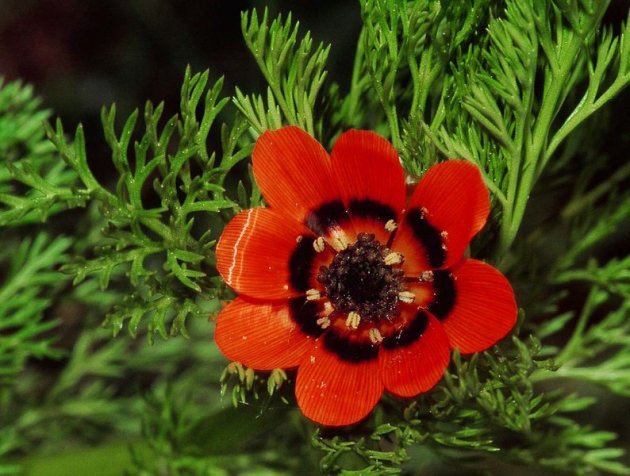
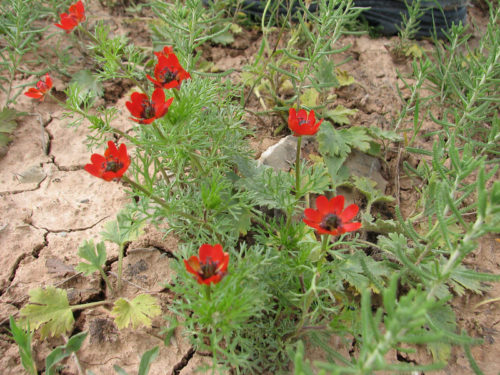
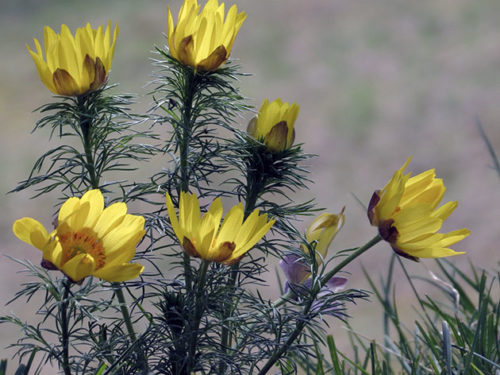
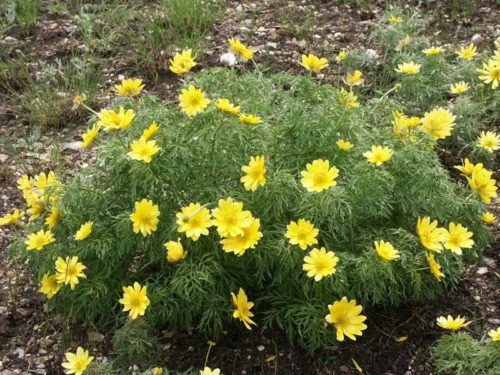
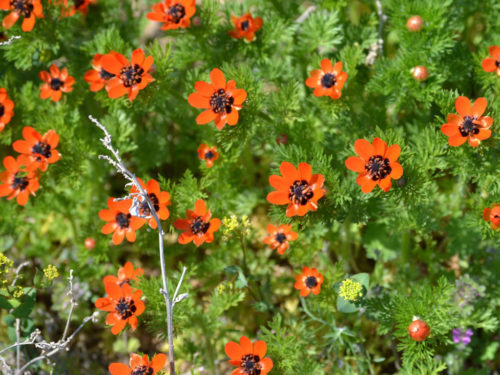
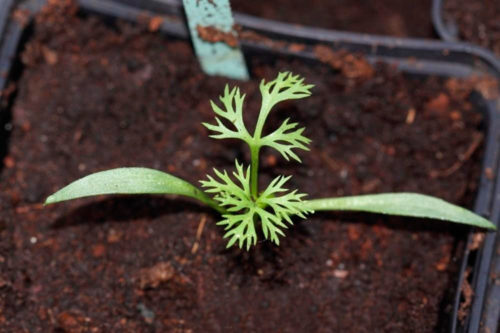

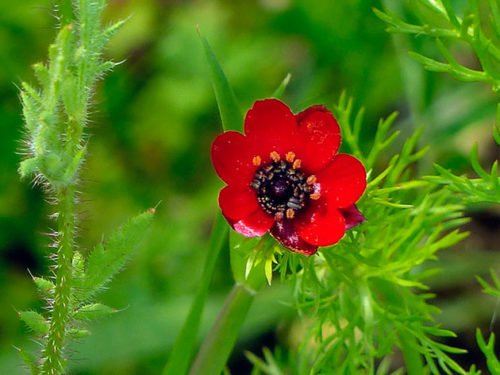
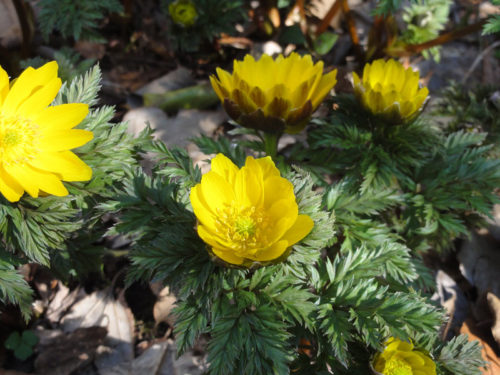
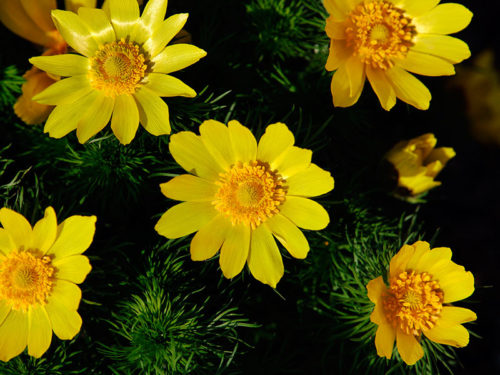
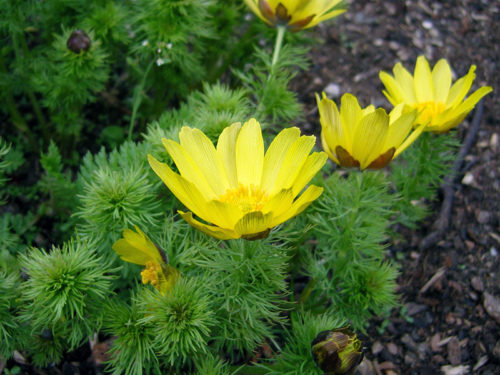
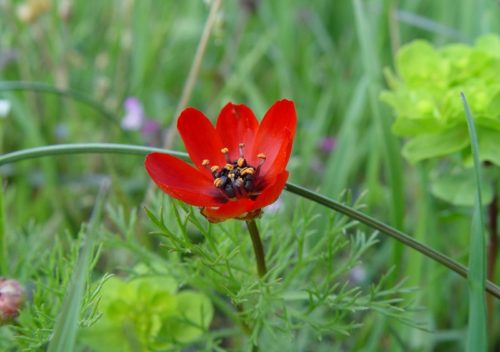
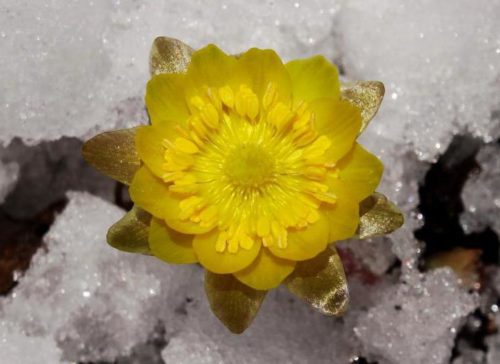
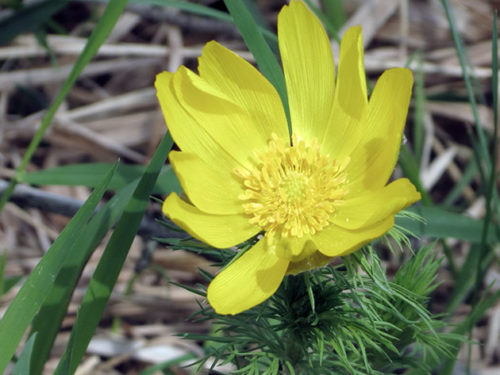
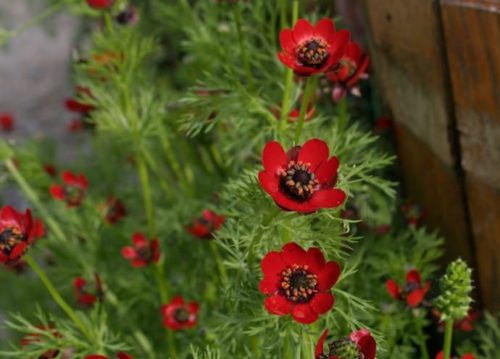












 Start a discussion ...
Start a discussion ...